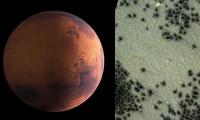WARSAW: Poland and Ukraine held separate ceremonies on Sunday marking 75 years since a WWII-era ethnic conflict between their nations claimed thousands of lives, as a row over history continued to sour bilateral ties.
Discord over the Volhynia massacres between 1943 and 1945 has led to a diplomatic chill between Kiev and Warsaw, whose relations deteriorated after the nationalist Law and Justice (PiS) party came to power in Poland in 2015.
Polish President Andrzej Duda attended a mass commemorating the Polish victims of the conflict in Lutsk, a city in Ukraine’s western Volhynia region. Ukrainian leader Petro Poroshenko, meanwhile, was in the Polish village of Sahryn, 125 kilometres across the border, where he opened a memorial to Ukrainians killed by Polish partisans.
In 2016, Poland’s rightwing-dominated parliament recognised the Volhynia massacres as a "genocide", a term that Kiev has rejected. Between 1942 and 1945, members of the Ukrainian Insurgent Army (UPA) killed up to 100,000 Poles in the Volhynia region of what is now northwest Ukraine.
The UPA’s main objective was to win Ukraine’s independence by ousting Nazi and later Soviet occupiers and to clear Poles from territories that were historically Ukrainian land.
"It was ethnic cleansing, so that’s what we would call it today," Duda said, quoted by the PAP Polish news agency at a cemetery in Olyka, near Lutsk.
The 2016 Polish resolution also recognises bloody reprisals by Polish partisan groups against Ukrainians that various sources say could have claimed up to 20,000 lives.
Duda also made reference to the reprisals by Polish partisan groups, but questioned the scale of the killing, insisting that there were around 5,000 victims. Speaking in Sahryn, Ukraine’s Poroshenko told members of Poland’s Ukrainian community that "our nations deserve to know the truth, but it is not the job of politicians."
Liberal Justice Elena Kagan on Sept. 13, 2016. — Slate website WASHINGTON: U.S. Supreme Court justices, wading back...
A representational image of inmates behind jail bars. — Unsplash/FileMOSCOW: A Russian court on Wednesday ordered...
Sudanese soldiers guard the surrounding area of the UNMIS compound in El-Fasher, the administrative capital of North...
US quietly shipped ATACMS missiles to Ukraine. — Report news agencyWASHINGTON: The United States in recent weeks...
US President Joe Biden during his address in California. — AFP FileWASHINGTON: President Joe Biden signed a...
The World Meteorological Organisation flag. — AFP FileGENEVA: Global temperatures hit record highs last year, and...







